If you are an off-road fanatic, you probably already know how having the right gear and settings in your ride can make or break your entire adventure. 4WD is the best setting to truly enjoy thorough mountain driving and get all high on the adrenaline. Four-Low (4L) and Four-High (4H) modes are two of the most crucial features of a 4WD ride. These modes ensure that you can easily take on any kind of terrain, from rocky inclines to muddy trails.
But the question remains: how do these two off-road modes differ, and which one should you use for specific road conditions?
Thus, if you are planning an exploration trip solo or with family or friends, you need to know 4H vs 4L. In this guide we will dive into:
- 4 high vs 4 low
- when to use them
- how to switch between the two
- safety tips for using each of these modes
- their maintenance and troubleshooting
- best 2025 vehicles featuring them, and more.
Let’s begin.
Understanding 4L and 4H Driving Modes
If while off-roading you desire to unleash the full potential of your vehicle, you need to clearly understand its specific drive modes. Four-wheel drive is the drive type typically used in adventure-oriented rides, and its two fundamental modes, Four-Low (4L) and Four-High (4H), are designed to tackle a variety of challenging roads. Knowing the ins and outs of 4L and 4H can significantly enhance your off-road experience and help you maneuver your ride through rocky landscapes or navigate slippery trails without breaking a sweat.
What is 4H (4 High)?
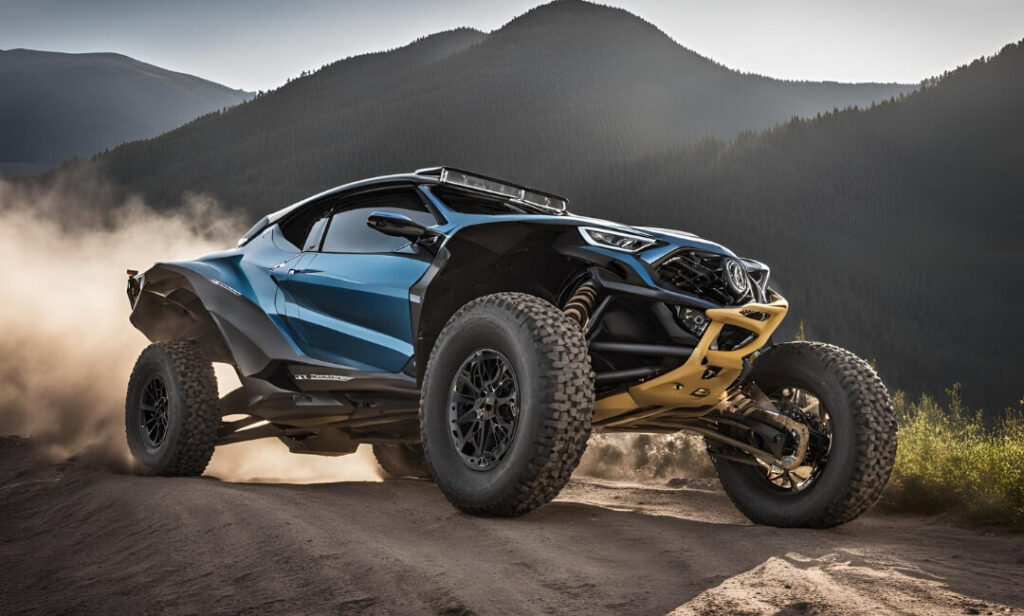
The Four-High drivetrain is perfect for higher-speed situations where you need traction but not the extreme torque. This mode divides power evenly between the front and rear wheels, providing stability and grip on moderately challenging terrains.
Key Features of 4H:
- Moderate torque: Balances power and speed.
- Higher speed capability: Suitable for faster off-road travel.
- Improved stability: Excellent for wet or slippery conditions.
What is 4L (4 Low)?
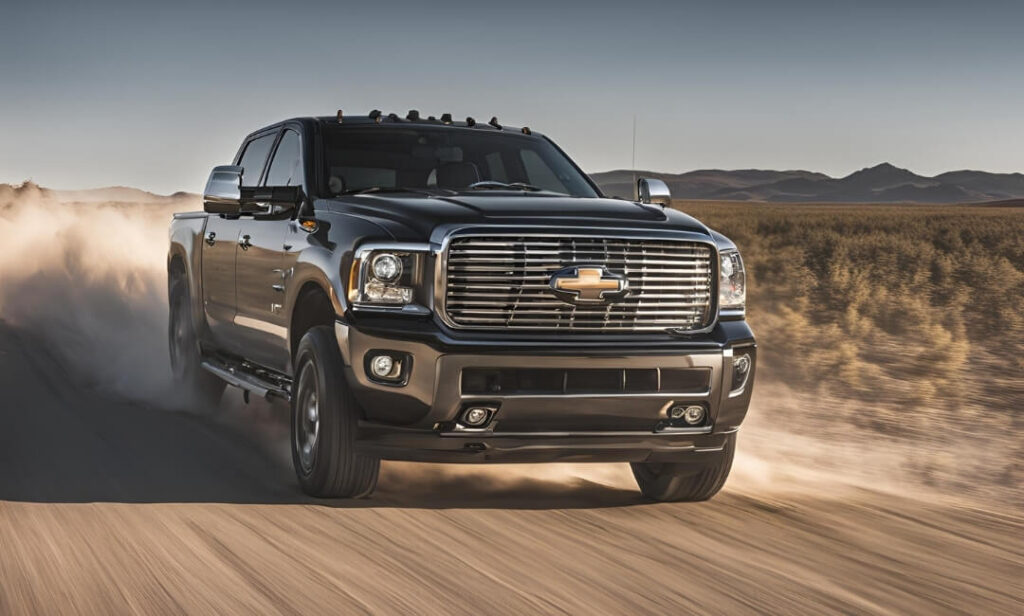
The Four-Low drivetrain, on the other hand, is designed for maximum torque and traction at low speeds. It engages your vehicle’s transfer case to multiply torque, delivering power to all four wheels at the same time. 4L mode is ideal for situations where you need controlled power, such as:
- Rock crawling
- Steep hill climbs or descents
- Driving through deep sand, mud, or snow
Key Features of 4L:
- Increased torque: Allows for precise control in challenging conditions.
- Low speed: Optimized for slow navigation.
- Maximized traction: Prevents wheel slippage on uneven surfaces.
Head-to-Head Showdown of 4H vs 4L Drive Modes
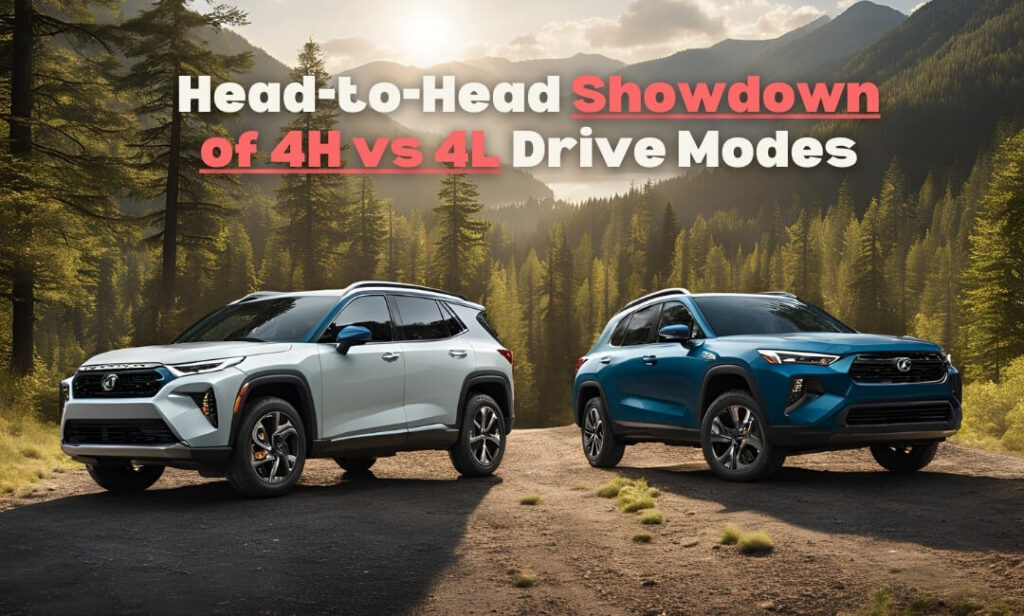
Four-High (4H) and Four-Low (4L) are two off-road modes that are distinct and offer different purposes. Understanding how they are different from each other will help you immensely in deciding which mode is best for the driving conditions and terrain you will face on your next adventurous trip.
| Feature | 4L (Four-Low) | 4H (Four-High) |
| Ideal Terrain | Rocky, steep inclines, deep mud/snow | Gravel, wet roads, light off-roading |
| Speed Range | 0-20 mph | 20-55 mph |
| Torque Output | Maximum | Moderate |
| Traction | Extreme | Moderate |
| Fuel Efficiency | Lower (due to high torque demands) | Higher (optimized for speed) |
| Steering Control | Reduced maneuverability | Improved steering at higher speeds |
1. Ideal Terrain
The 4L is ideal for rocky paths and boulders, steep inclines or declines, and deep mud or snow. Whereas 4L is great to use on gravel roads and light trails, wet or icy roads, and moderate off-road scenarios.
4 Low:
- Rocky paths and boulders: The increased torque and slow wheel rotation help you crawl over obstacles without losing traction.
- Steep inclines or declines: The lower gear ratio provides strong power to go uphill and safe engine braking when on downhill slopes.
- Deep mud or snow: 4L’s power distribution helps your wheels churn through thick, slippery surfaces without getting bogged down.
4 High:
- Gravel roads and light trails: 4H offers a balanced mix of speed and power, making it the best for less extreme off-road surfaces.
- Wet or icy roads: The four-wheel engagement helps maintain control and grip, preventing skidding in mildly slippery conditions.
- Moderate off-road situations: 4H provides easy stability at higher speeds when the terrain isn’t too rough.
2. Speed Range
4L has a low gear ratio, meaning it works best at absolute low speeds, whereas 4H is great for moderate to high speeds.
4 Low:
- 0–20 mph (approx.): With 4L your vehicle is in low gear, thus moves slowly. This helps you handle your ride precisely.
- Low-speed crawling: This mode is only for slow, controlled driving. So, never make the mistake of using it for quick coverage of large distances.
4 High:
- 20–55 mph (approx.): The exact speed numbers vary by vehicle, but 4H is ideal for moderate to fast speeds, generally between 20 and 55 mph.
- Smooth and steady cruising: It provides a stable ride on rough roads without the jerky movement of 4L.
3. Torque Output
If more torque output is the demand of the terrain you are driving on, go for 4L. But if more balanced power delivery is necessary, 4H is your true friend.
4 Low:
- Maximum Torque: The engagement of 4L gives a huge torque boost to your vehicle, helping it power through tough obstacles or sticky terrain.
- High stress on the Drivetrain: With 4L, you are using higher torque with low gears, making your vehicle’s components work harder than usual.
4 High:
- Moderate Torque: With 4H you get more torque than a regular two-wheel drive type; however, it is not as much as 4L.
- Balanced Power Delivery: You get extra traction for challenging road conditions minus the intense, crawl-focused torque of 4L.
4. Traction and Grip
4L is right for extreme traction as it decreases the overall wheel spin, whereas 4H shines with its moderate traction and provides steady grip on mild terrains.
4 Low:
- Extreme Traction: Each wheel gets more power at lower speeds, helping to prevent spinning or slipping.
- Less Wheel Spin: This mode works well in reducing the wheel spin, making it especially useful on slippery or uneven terrain and keeping you in full control of your ride.
4 High:
- Moderate Traction: In this mode you will get power supply to all four wheels, but overall it is optimized for more speed.
- Steady Grip: It offers impressive control on loose gravel or light snow, much better than a two-wheel drive system.
5. Fuel Efficiency
4L reduces the efficiency of your ride and thus should be used for short distances. In comparison, 4H provides better fuel economy and can be used without worry over long distances. Our fuel mileage calculator can help you determine the true efficiency of your ride at every step of your journey.
4 Low:
- Lower Efficiency: Running your ride in lower gears at high torque usually increases its fuel consumption.
- Ideal for short distances only: As the fuel usage is high, 4L should only be used for challenging sections of your journey. Avoid using it for long stretches.
4 High:
- Relatively better efficiency than 4L: All 4WD modes use more fuel than 2WD. However, 4H is still more economical than 4L because it works at higher gears and moderate torque.
- Usable over longer distances: It is easier for your ride to maintain a decent riding speed with 4H without overstressing the engine.
6. Steering and Control
With 4L, the steering might feel heavier, but you get great ride control at slower speeds. While with 4H, you can easily handle your vehicle even at higher speeds and do balanced cornering.
4 Low:
- Heavier steering feel: Because of the low gear and intense torque, steering can feel more rigid with 4L.
- Greater control in slow maneuvers: This 4WD mode is perfect for times when you need precise wheel placement to carefully get your way around tight trails or large rocks.
4 High:
- Easier handling at speed: 4H ensures more responsive steering in moderate-speed trails or highway stretches with low traction.
- Balanced cornering: The distribution of power to all four wheels helps maintain stability, especially when turning on slippery or uneven surfaces.
7. Use Cases and Practical Tips
4L is ideal for extremely challenging terrains and precise maneuvers, whereas 4H is ideal to drive in snow and moderately challenging trails with steady speed.
4 Low:
- When to engage: Use it to cross steep climbs, descents, deep mud, or heavy rock crawling.
- Driving style: Slow, methodical, and focused on precise maneuvers.
- Safety note: Avoid turning too sharply on high-traction surfaces, as this drivetrain can bind and cause damage.
4 High:
- When to engage: Use 4H if the road ahead is mildly challenging, such as a snowy road, gravel track, or moderate off-road trail.
- Driving style: Steady speed, smooth acceleration, and cautious cornering.
- Safety note: 4H still puts more strain on the vehicle than 2WD, so be mindful of prolonged use on dry pavement.
When to Use 4L and 4H Off-Road Modes?
The timing of using the 4L and 4H modes of your ride can make all the difference on the road. If you know when to switch between them, you will get the right balance of power, control, and speed for any situation that your journey might throw in your face.
On your outdoor adventure, you will come across various off-road scenarios, from steep, rocky climbs to slippery, wet roads. And we can help you decide which mode is the best fit for each of these terrains.
Ideal Scenarios for 4H Usage
- Wet or Icy Roads: It improves the grip on slippery surfaces without sacrificing speed.
- Light Trails: 4H can easily handle gravel or dirt paths with ease.
- Snowy Conditions: You get better stability at moderate speeds, especially during winter adventures.
Ideal Scenarios for 4L Usage
- Rock Crawling: The extra torque allows for slow, controlled movement over the boulders.
- Mud and Sand: 4L prevents the wheels from spinning excessively, helping you power through deep terrains.
- Steep Hills: You get better engine braking while descending and enough power to climb steep slopes.
Selecting and Operating the Right 4WD Mode for Your 2025 Off-Road Adventure
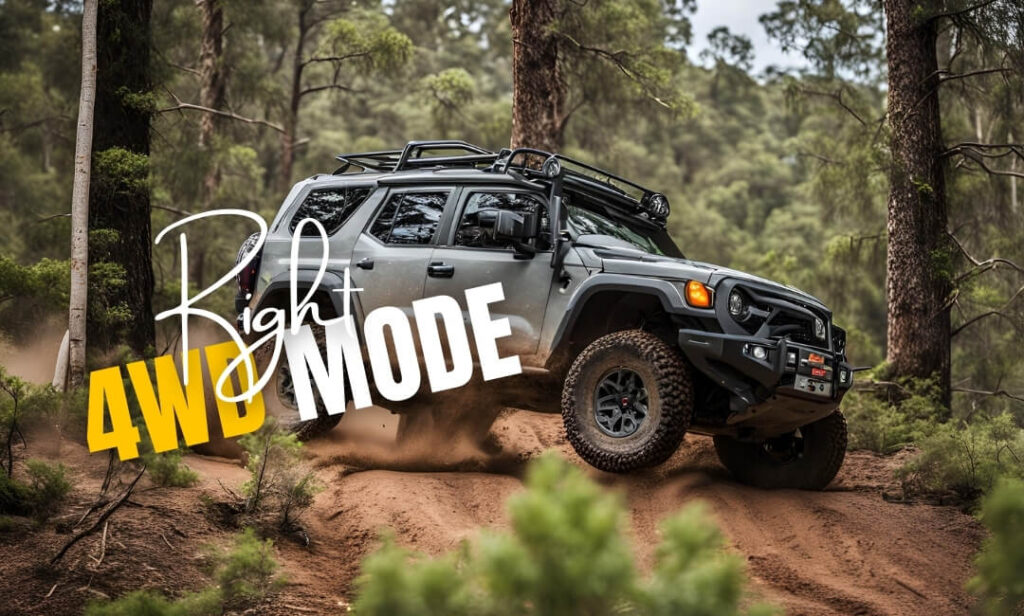
For safe navigation through off-road trails, you not only need to know what 4L and 4H are and when to use each of them but also how to employ these modes correctly. Because if you are unable to apply one while the vehicle is moving, you increase your risk of getting into an accident.
Thus, it is necessary you learn how to select and operate the right 4WD mode for your 2025 off-road adventures:
1. Know Your Vehicle
Before you begin your journey to the wild, it is advised to know your ride inside and out. Refer to your vehicle’s owner’s manual to learn about the specific guidelines for its 4WD system. Different manufacturers may have slightly different procedures or limitations, and you need to know such details about your automobile.
Modern 4WD or 4X4 vehicles, such as the 2025 Toyota 4Runner, Jeep Wrangler Rubicon, and others, come equipped with advanced technology that makes switching between 4H and 4L flawless. Whereas in older rides like an Isuzu Trooper, the same task is tough and requires better and more precise understanding from the driver.
2. Assess the Terrain
Carefully examine the road ahead and understand the challenges before engaging either of the two modes. If there are extreme conditions like deep mud, steep inclines, rocky obstacles, or snow, go for 4L mode. Use 4H if driving on moderate off-road trails or slippery surfaces where a higher speed is manageable.
3. Monitor Your Speed
Always, always drive within the recommended speed ranges for each mode to avoid mechanical strain and severe damage to your ride. 4L should be engaged at very low speed (typically 0–20 mph) to maintain maximum control. Whereas for a faster drive (usually 20–55 mph), 4H is right, but avoid sudden acceleration or braking as it can upset the balance of your vehicle.
4. Smooth Transitions
When switching between the two modes (which we will learn in detail in the following section), make sure your automobile is either moving very slowly or is at a complete stop, as recommended by the manufacturer. Doing this will minimize the risk of drivetrain damage.
5. Tire and Traction Check
Make sure your tires are in good condition and are well suited for off-road conditions. Adequate tread and proper inflation are absolutely necessary for optimal traction and handling.
6. Environmental Awareness
Never ignore the weather conditions. Wet, icy, or extremely muddy surfaces require more caution than the dry roads. So, adjust your driving style accordingly and be ready to switch back to a more appropriate mode if conditions change.
7. Regular Drills and Practice
Practice shifting between 4L and 4H modes in a controlled driving environment before taking on your new terrain challenge. Doing this will build your muscle memory and help you respond quickly and confidently in unexpected situations.
8. Emergency Preparedness
Whenever going on a challenging off-road adventure, always carry recovery gear, a first aid kit, and communication devices. Knowing how to handle minor mishaps can come in extremely handy when exploring the road less taken.
Step-by-Step Guide for Smooth Transition Between 4L and 4H
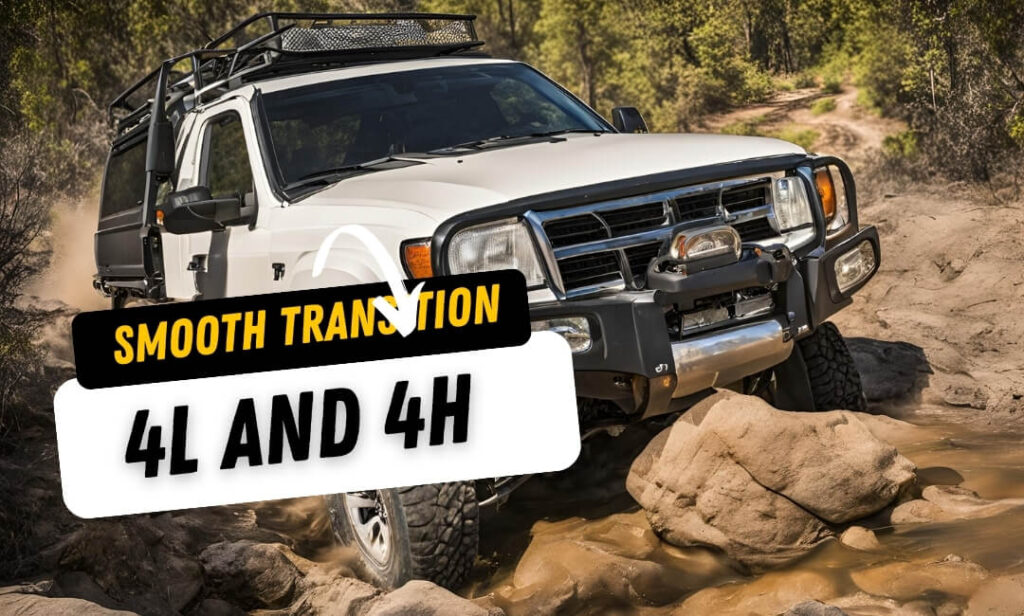
The smooth transition between 4L and 4H is highly critical for maximizing the performance of your vehicle and simultaneously preventing any kind of damage. If you want to ensure safe and effective mode change in your tough adventure partner, we recommend you follow the following steps:
1. Prepare Your Vehicle
Firstly, ensure that your vehicle is either completely stopped or is moving at a very slow speed (ideally under 5 mph). To be sure about the speed, refer to the owner’s manual of your ride. Some automobiles require you to shift into neutral before switching the 4WD modes. Find whether your ride needs to do so through the same manual.
2. Examine the Dashboard
Make sure the appropriate 4WD indicator light on your dashboard is off or is showing that your ride is ready to transition. If any warning lights are illuminating, it signals that there is an underlying issue that needs your immediate attention.
3. Select the Desired Off-Road Mode
Once you have ensured there is nothing wrong with your vehicle, it is time to select or shift into the desired 4WD mode.
- Shifting to 4L: To shift to 4L, first move the transfer case lever or press the designated button to select Four-Low. Now wait for the system to confirm engagement. It is usually signified by an indicator light or message on the dashboard.
- Shifting to 4H: If you are already in 4L, first shift back to neutral (if required), then select the Four-High. Now again, wait for the confirmation from the system via your dashboard.
4. Double-Check Engagement
Before you start your drive again, always double-check the engagement of the modes. Look at your dashboard or instrument panel to ensure that your desired mode has been successfully engaged. To be double sure, listen for the sounds. Every time you shift the modes, there is a brief mechanical sound, which is common. If you find the noise unusually loud or if your vehicle feels off, stop and recheck your system.
5. Resume Driving
Once you have confirmed that the drive mode is engaged smoothly, gradually resume your drive. We suggest paying close attention to how your ride responds, especially in challenging terrain, and be prepared to switch modes again if required.
How To Keep Your 4WD System in Top Shape
A well-maintained 4WD system is a must for performance and longevity. It does not matter how good you are shifting gears or how well you can drive, if the drivetrain system of your ride is in bad condition you can get into some serious trouble on the road. But the good news is that with proper maintenance and troubleshooting, you can avoid it all. Here’s how you can keep your system running smoothly:
1. Routine Inspections
Make a routine to check the transfer case, drive shafts, and differentials for signs of wear or damage. Look for leaks, unusual noises, or vibrations during operation. Doing this once every week will help you immensely.
2. Fluid Checks and Changes
The transfer case and differentials require specialized fluids that need to be at a desired level and require periodic replacement. To know the proper fluid levels and when to change them, follow your vehicle’s maintenance schedule as provided in the owner’s manual.
3. Tire Maintenance
Off-roading is especially tough on your tires. So, inspect them for cuts, punctures, or abnormal wear patterns before and after every single one of your adventurous trips. Ensure that tire size and pressures are appropriate for both on-road and off-road conditions. If the damage is too much, consider replacing them. You can use our tire size calculator to double-check what size of tires will be most suitable for your ride.
4. Engagement Mechanism
Test the mechanism that switches between 4L and 4H. If the transition feels rough or you notice any delays, consult a professional before taking your next trip to the unknown.
5. Diagnostic Tools
The diagnostic tools are really handy in keeping your ride. While you may need to buy one separately for older vehicles, the modern ones often come with onboard diagnostics. Use these tools to monitor system health and catch issues early before they can cause some serious damage.
6. Professional Servicing
The regular at-home maintenance is all good. However, you need professional assistance from time to time. Take your ride to a trusted mechanic once every 3 to 4 months and have your 4WD system inspected. This will help you pick up on any potential issues and resolve them before they lead to major failures.
Troubleshooting Common Issues
If you ever encounter any issue with your vehicle’s four-wheel drive, it is wise to consult a professional. However, there are some common issues that you can troubleshoot all on your own.
- Warning Lights: If any warning light on your dash related to the drivetrain is illuminating, do not ignore them. Just handle them as soon as possible to avoid further damage.
- Delayed Engagement: If you find your 4WD system to be slow to engage, it is mostly due to low fluid levels. Just check the fluid tank and refill as required.
- Strange Noises: If you hear unusual clunking or whining sounds while engaging the system, it often indicates worn-out gears or bearings. Just replace them, and you are good to go.
4WD vs AWD vs 2WD to Find Which Drivetrain Suits Your Driving Needs the Best
To fully enjoy your journey, you need to select the ride-drive mode, and this can only happen by understanding the differences between 4WD, AWD, and 2WD.
Drive Type – 4WD
- Usage: Best for rugged off-road conditions and extreme weather.
- Strengths: Maximum traction with the ability to switch between 4L and 4H modes for various challenges.
- Considerations: Typically lower fuel efficiency on paved roads; more mechanical complexity and higher drivetrain stress.
Drive Type – AWD
- Usage: Ideal for daily on-road driving with occasional light off-road or adverse weather conditions.
- Strengths: Provides continuous power to all wheels for enhanced grip and stability on mixed surfaces.
- Considerations: Not as effective for extreme off-road adventures; lacks the low-speed torque multiplication found in 4WD systems.
Drive Type – 2WD
- Usage: Suitable for everyday driving on paved roads.
- Strengths: Simpler system offering better fuel efficiency and lower maintenance costs.
- Considerations: Limited traction in slippery or rough terrain; not recommended for serious off-road use.
Future Trends in Off-Road Technology and 4WD Systems
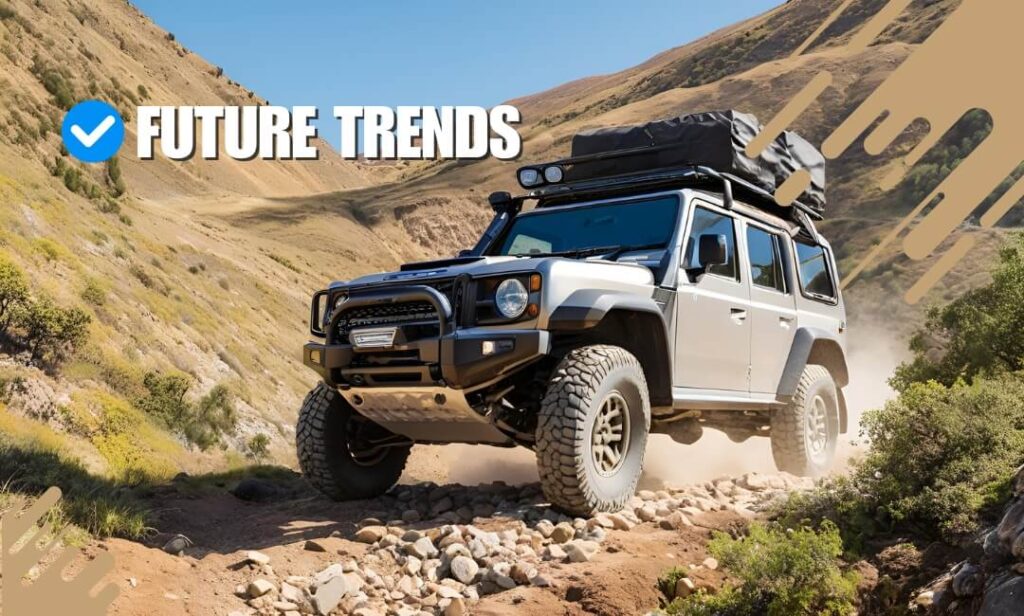
The craze for off-roading is never going to die. This is the reason why the evolution of off-road technology continues to accelerate with the blending of advanced engineering with smart technology.
Here, take a look at what the future for the adventure driving may hold:
- Integration of AI and Machine Learning: There are high chances that, like any other automotive tech, the future 4AWD systems may also incorporate AI to dynamically adjust power distribution based on real-time terrain analysis. Such a technology will be able to optimize performance and safety by predicting and responding to changes before the driver even notices them.
- Electrification and Hybrid Powertrains: As electric and hybrid vehicles are becoming more prevalent with each passing year, off-road systems are also evolving. Electric torque can be delivered instantaneously, providing enhanced low-speed power and precise control, which is particularly beneficial in challenging terrains.
- Advanced Sensor Technology: The use of LiDAR, cameras, and other sensor technologies is highly likely to increase. These sensors can provide you a detailed feedback on road conditions, allowing you to strategize better control of your 4WD system and simultaneously reducing the risk of getting stuck or damaging your drivetrain.
- Automated Mode Switching: Future adventure vehicles might automatically switch between 4L and 4H based on the driving conditions. This technology would reduce your workload and improve the overall performance of your ride during off-road excursions.
- Improved Durability and Materials: Advancements in materials science may lead to more durable and lightweight components for transfer cases and drive shafts, enhancing the longevity and efficiency of 4WD systems.
- Connectivity and Data Analytics: Enhanced connectivity will allow off-road automobiles to share data with centralized systems, helping manufacturers improve designs and providing drivers with real-time performance analytics and maintenance alerts. All these innovations promise to make off-road driving not only more accessible but also considerably safer and more efficient.
9 Best 4 High Vehicles for 2025
If you are in the market to buy a robust automotive partner for your off-road adventures, then we have some of the best 4H models shortlisted for you. All of these models are optimized for higher-speed off-road driving with enhanced stability, control, and moderate torque, providing easier navigation through gravel roads, wet surfaces, and light off-road trails.
| Rank | Vehicle | Description |
| 1 | Jeep Wrangler Rubicon 4xe | Hybrid technology meets advanced 4H systems, delivering efficiency and smooth power for both on- and off-road adventures. |
| 2 | Ford Bronco Wildtrak | Engineered with a sophisticated 4H system, it excels on loose surfaces, wet roads, and moderately rugged trails. |
| 3 | Toyota 4Runner TRD Off-Road (2025 Edition) | A balanced performer offering excellent stability and traction across a wide range of off-road conditions. |
| 4 | Land Rover Defender X | Combines luxury with capability—its 4H mode ensures agility and safety whether on paved highways or rugged byways. |
| 5 | Chevrolet Colorado ZR2 Bison | Built for versatility, this truck’s 4H mode offers impressive control at higher speeds while meeting off-road challenges. |
| 6 | Nissan Patrol 4×4 Adventure | Designed to handle wet, icy, and moderately off-road terrains with a reliable and responsive 4H system. |
| 7 | Ram 1500 Rebel | Merges power with refined 4H dynamics, making it suited for both highway cruising and tackling varied off-road conditions. |
| 8 | Mercedes-Benz G-Class (2025 Edition) | A blend of premium design and rugged capability, optimized for steady high-speed off-road performance in its 4H mode. |
| 9 | Ford F-150 Raptor (2025) | An off-road powerhouse using its advanced 4H configuration to maintain stability and speed over challenging terrains. |
9 Best 4 Low Vehicles for 2025
If you are more inclined towards 4L, all the vehicles listed below are tailored for extreme low-speed crawling road situations. Their 4L mode delivers maximum torque and control, ideal for rock crawling, steep inclines, deep mud, and other high-demand off-road conditions.
| Rank | Vehicle | Description |
| 1 | Jeep Wrangler Rubicon | The archetypal rock crawler engineered for precision on rocky terrain and steep obstacles. |
| 2 | Toyota Land Cruiser Heritage Edition (2025) | Known for durability and power, its robust 4L system provides unmatched low-speed torque under extreme conditions. |
| 3 | Ford Bronco Rock Crawler Edition | Specifically tuned for hardcore off-roading with superior crawl ratios and control for rugged landscapes. |
| 4 | Jeep Gladiator Mojave Rock Edition | A rugged pickup built for low-speed, high-torque performance—ideal for extreme off-road maneuvers and rock crawling. |
| 5 | Chevrolet Colorado ZR2 (Rock Edition) | Tuned for rock crawling, ensuring maximum torque and traction on uneven terrain. |
| 6 | Land Rover Defender Rock Edition | Enhanced for precise low-range operation, designed for obstacle-laden and steep paths. |
| 7 | Hummer EV Rubicon Edition | An electric off-road beast offering instant torque and advanced 4L capabilities for challenging climbs and obstacles. |
| 8 | Nissan Titan Off-Road Pro (2025) | Engineered for heavy-duty rock crawling, delivering consistent low-speed performance and robust traction. |
| 9 | Mercedes-Benz G-Class Rock Edition | Featuring specialized 4L tuning, it’s built to conquer extreme off-road conditions with precision and ease. |
Relevant FAQs For 4 High Vs 4 Low
What is the difference between 4L and 4H?
4L, or Four Low, is an off-road driving mode that is used for low-speed, high-torque situations like rock crawling, steep climbs, and deep mud or snow. Whereas 4H, or Four High, is ideal for driving on rough but less extreme surfaces at moderate speeds, offering a good balance of speed and traction.
Can I use 4L or 4H on paved roads?
As per industry experts, you should never use 4L on paved roads due to the increased drivetrain strain and reduced fuel efficiency. In contrast, 4H can sometimes be used in adverse weather conditions on paved roads. But overall, it is ideal for off-road or mixed-terrain driving.
How do I safely transition between 4L and 4H?
For the safe transition between the two distinct drive modes, most vehicles require you to either be at a complete stop or low speed or shift into neutral. But to be 100% sure, it is better to take a reference from your owner’s manual. It comprises the proper procedure for the transition, including every minute detail that you need to take care of.
What advantages does 4 High offer over 4 Low?
4 High provides moderate torque at higher speeds, making it ideal for driving conditions where you need stability and traction without sacrificing speed. It’s well-suited for gravel roads, light off-roading, and driving on wet or icy surfaces.
What maintenance does a 4WD system require?
Your 4WD system requires some crucial regular maintenance, such as inspecting the transfer case, drive shafts, and differentials, as well as timely fluid changes. Perform these tasks as per the manufacturer’s recommended schedule, and you will ensure peak performance and longevity of your 4WD system.
Conclusion
The 4h vs 4l discussion is crucial for all off-road fanatics. It does not matter which one you prefer; knowing and mastering each is a must for safe and secure adventure driving. 4H offers balanced speed and grip for moderate terrains, whereas 4L is all about traction to tackle the toughest conditions. Understanding when and how to use each of these drive modes can elevate your off-road experience and ensure your adventures remain safe and thrilling. So, the next time you gear up for an off-road trip, just remember that the right mode can make all the difference.


